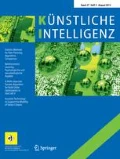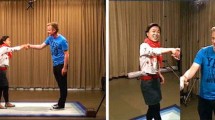Abstract
Researchers in the fields of AI and Communication both study human communication, but despite the opportunities for collaboration, they rarely interact. Red Hen Lab is dedicated to bringing them together for research on multimodal communication, using multidisciplinary teams working on vast ecologically-valid datasets. This article introduces Red Hen Lab with some possibilities for collaboration, demonstrating the utility of a variety of machine learning and AI-based tools and methods to fundamental research questions in multimodal human communication. Supplemental materials are at http://babylon.library.ucla.edu/redhen/KI.

Similar content being viewed by others
References
Fong T, Nourbakhsh I, Dautenhahn K (2003) A survey of socially interactive robots. Robot Auton Syst 42(3):143–166
Jaimes A, Sebe N (2007) Multimodal human–computer interaction: a survey. Comput Vis Image Underst 108(1):116–134
Ende T, Haddadin S, Parusel S, Wüsthoff T, Hassenzahl M, Albu-Schäffer A (2011) A human-centered approach to robot gesture based communication within collaborative working processes. In: Intelligent robots and systems (IROS), 2011 IEEE/RSJ international conference on, pp 3367–3374. IEEE
Gleeson B, MacLean K, Haddadi A, Croft E, Alcazar J (2013) Gestures for industry: intuitive human–robot communication from human observation. In: Proceedings of the 8th ACM/IEEE international conference on Human-robot interaction, pp 349–356. IEEE Press
Yanik PM, Manganelli J, Merino J, Threatt AL, Brooks JO, Green KE, Walker ID (2014) A gesture learning interface for simulated robot path shaping with a human teacher. IEEE Trans Hum Mach Syst 44(1):41–54
Chen LS, Huang TS (2000) Emotional expressions in audiovisual human computer interaction. In: Multimedia and Expo, 2000. ICME 2000. 2000 IEEE international conference on, vol 1, pp 423–426. IEEE
Busso C, Deng Z, Yildirim S, Bulut M, Lee CM, Kazemzadeh A, Lee S, Neumann U, Narayanan S (2004) Analysis of emotion recognition using facial expressions, speech and multimodal information. In: Proceedings of the 6th international conference on multimodal interfaces, pp 205–211. ACM
Pantic M, Sebe N, Cohn JF, Huang T (2005) Affective multimodal human–computer interaction. In: Proceedings of the 13th annual ACM international conference on multimedia, pp 669–676. ACM
Caridakis G, Castellano G, Kessous L, Raouzaiou A, Malatesta L, Asteriadis S, Karpouzis K (2007) Multimodal emotion recognition from expressive faces, body gestures and speech. Artificial intelligence and innovations 2007: from theory to applications, pp 375–388
Soleymani M, Pantic M, Pun T (2012) Multimodal emotion recognition in response to videos. IEEE Trans Affect Comput 3(2):211–223
Suchan J, Bhatt M (2016) Semantic question-answering with video and eye-tracking data: AI foundations for human visual perception driven cognitive film studies. IJCAI, pp 2633–2639
Suchan J, Bhatt M (2016) The geometry of a scene: on deep semantics for visual perception driven cognitive film studies. WACV, pp 1–9
Cassell J, Kopp S, Tepper P, Ferriman K, Striegnitz K (2007) Trading spaces: how humans and humanoids use speech and gesture to give directions. Conversational informatics, pp 133–160
Kopp S, Bergmann K, Wachsmuth I (2008) Multimodal communication from multimodal thinking towards an integrated model of speech and gesture production. Int J Semant Comput 2(01):115–136
Marsella S, Xu Y, Lhommet M, Feng A, Scherer S, Shapiro A (2013) Virtual character performance from speech. In: Proceedings of the 12th ACM SIGGRAPH/Eurographics symposium on computer animation, pp 25–35. ACM
Huang C-M, Mutlu B (2014) Learning-based modeling of multimodal behaviors for humanlike robots. In: Proceedings of the 2014 ACM/IEEE international conference on human–robot interaction, pp 57–64. ACM
Li W, Joo J, Qi H, Zhu S-C (2017) Joint image-text news topic detection and tracking by multimodal topic and-or graph. IEEE Trans Multimedia 19(2):367–381
Deng J, Dong W, Socher R, Li L-J, Li K, Fei-Fei L (2009) Imagenet: a large-scale hierarchical image database. In: Computer vision and pattern recognition
Karpathy A, Toderici G, Shetty S, Leung T, Sukthankar R, Fei-Fei L (2014) Large-scale video classification with convolutional neural networks. In: Proceedings of the IEEE conference on computer vision and pattern recognition, pp 1725–1732
Lin T-Y, Maire M, Belongie S, Hays J, Perona P, Ramanan D, Dollár P, Zitnick CL (2014) Microsoft coco: common objects in context. In: European conference on computer vision, pp 740–755
Joo J, Steen FF, Zhu S-C (2015) Automated facial trait judgment and election outcome prediction: social dimensions of face. In: Proceedings of the IEEE international conference on computer vision, pp 3712–3720
Groeling T, Li W, Joo J, Steen FF (2016) Visualizing presidential elections. In: APSA annual meeting
Joo J, Li W, Steen FF, Zhu S-C (2014) Visual persuasion: inferring communicative intents of images. In: Proceedings of the IEEE conference on computer vision and pattern recognition, pp 216–223
Tore N, Anna E, Janda LA, Makarova A, Steen F, Turner M (2013) How “here” and “now” in Russian and English establish joint attention in TV news broadcasts. Russ Linguist 37(3):229–251
Steen FF, Turner M (2013) Multimodal construction grammar. In: Borkent M, Barbara D, Jennifer H (eds) Language and the creative mind. CSLI Publications, University of Chicago Press. Stanford, CA, pp 255–274
Turner M (2017) Multimodal form-meaning pairs for blended classic joint attention. Linguist Vanguard. doi:10.1515/lingvan-2016-0043
Author information
Authors and Affiliations
Corresponding author
Rights and permissions
About this article
Cite this article
Joo, J., Steen, F.F. & Turner, M. Red Hen Lab: Dataset and Tools for Multimodal Human Communication Research. Künstl Intell 31, 357–361 (2017). https://doi.org/10.1007/s13218-017-0505-9
Published:
Issue Date:
DOI: https://doi.org/10.1007/s13218-017-0505-9




